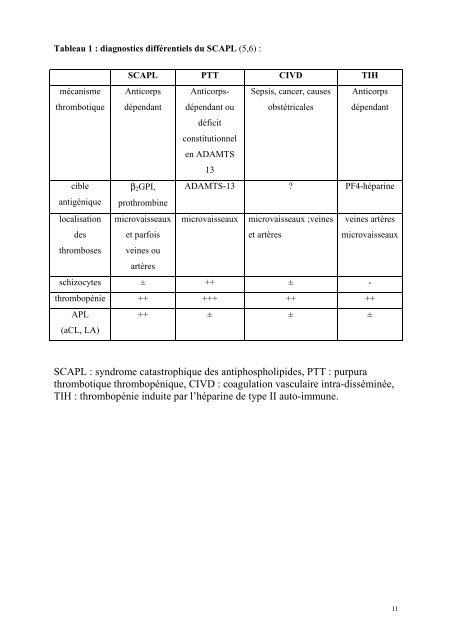Syndrome catastrophique des antiphospholipides
Syndrome catastrophique des antiphospholipides
Syndrome catastrophique des antiphospholipides
Create successful ePaper yourself
Turn your PDF publications into a flip-book with our unique Google optimized e-Paper software.
Tableau 1 : diagnostics différentiels du SCAPL (5,6) :<br />
mécanisme<br />
thrombotique<br />
cible<br />
antigénique<br />
localisation<br />
<strong>des</strong><br />
thromboses<br />
SCAPL PTT CIVD TIH<br />
Anticorps<br />
dépendant<br />
β2GPI,<br />
prothrombine<br />
microvaisseaux<br />
et parfois<br />
veines ou<br />
artères<br />
Anticorps-<br />
dépendant ou<br />
déficit<br />
constitutionnel<br />
en ADAMTS<br />
13<br />
Sepsis, cancer, causes<br />
obstétricales<br />
Anticorps<br />
dépendant<br />
ADAMTS-13 ? PF4-héparine<br />
microvaisseaux microvaisseaux ;veines<br />
et artères<br />
schizocytes ± ++ ±<br />
veines artères<br />
microvaisseaux<br />
thrombopénie ++ +++ ++ ++<br />
APL<br />
(aCL, LA)<br />
++ ± ± ±<br />
SCAPL : syndrome <strong>catastrophique</strong> <strong>des</strong> antiphospholipi<strong>des</strong>, PTT : purpura<br />
thrombotique thrombopénique, CIVD : coagulation vasculaire intra-disséminée,<br />
TIH : thrombopénie induite par l’héparine de type II auto-immune.<br />
-<br />
11



